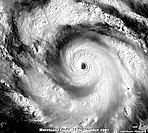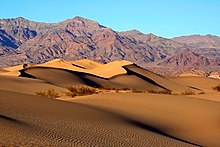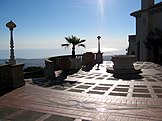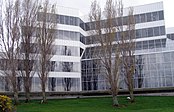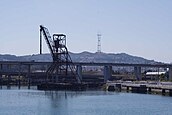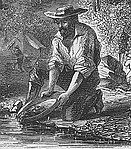Portal:California/Selected article/Archives
If you wish to add an article for rotation within this portal, please
- Check its unofficial rating by a WikiProject; it must be B-class or higher to qualify
- Add the article in to a subpage of this portal, such as Portal:California/Selected article/#, replacing the "#" with the number above the current highest. For example, if 21 articles are in rotation, you would make the number of the article you are creating 22.
- Update the article maximum parameter on the main Portal
- If possible, please accompany the article with a freely-licensed image (such as images released under the GFDL, Public Domain.) Fair use images are not permitted, per Wikipedia:Non-free content criteria.
- Update this list accordingly.
Articles in rotation
[edit]The Mono–Inyo Craters are a volcanic chain of craters, domes and lava flows in Mono County, Eastern California. The chain stretches 25 miles (40 km) from the northwest shore of Mono Lake to the south of Mammoth Mountain. The Mono Lake Volcanic Field forms the northernmost part of the chain and consists of two volcanic islands in the lake and one cinder cone volcano on its northwest shore. Most of the Mono Craters, which make up the bulk of the northern part of the Mono–Inyo chain, are phreatic (steam explosion) volcanoes that have since been either plugged or over-topped by rhyolite domes and lava flows. The Inyo volcanic chain form much of the southern part of the chain and consist of phreatic explosion pits, and rhyolitic lava flows and domes. The southernmost part of the chain consists of fumaroles and explosion pits on Mammoth Mountain and a set of cinder cones south of the mountain; the latter are called the Red Cones.
The region has been used by humans for centuries. Obsidian was collected by Mono Paiutes for making sharp tools and arrow points. Glassy rock continues to be removed in modern times for use as commercial scour and yard decoration. Mono Mills processed timber felled on or near the volcanoes for the nearby boomtown Bodie in the late 19th to early 20th centuries. Water diversions into the Los Angeles Aqueduct system from their natural outlets in Mono Lake started in 1941 after a water tunnel was cut under the Mono Craters. Mono Lake Volcanic Field and a large part of the Mono Craters gained some protection under Mono Basin National Forest Scenic Area in 1984. Resource use along all of the chain is managed by the United States Forest Service as part of Inyo National Forest. Various activities are possible along the chain, including hiking, bird watching, canoeing, skiing, and mountain biking. (Full article...)
Hurricane Linda was the strongest Pacific hurricane on record. Forming from a tropical wave on September 9, 1997, Linda steadily intensified and reached hurricane status within 36 hours of developing. Subsequently, it rapidly intensified, reaching winds of 185 mph (295 km/h) and an estimated central pressure of 902 millibars (26.65 inches of mercury). The hurricane was briefly forecast to move toward southern California, but instead, it turned out to sea and dissipated on September 17. It was the fifteenth tropical cyclone, thirteenth named storm, seventh hurricane, and fifth major hurricane of the 1997 Pacific hurricane season. While near peak intensity, Hurricane Linda passed near Socorro Island, where it damaged meteorological instruments. The hurricane produced high waves along the southwestern Mexican coastline, forcing the closure of five ports. When Linda was predicted to make landfall on California, it would have been the first to do so since a storm in 1939. Although it did not hit the state, the hurricane produced light to moderate rainfall across the region, causing mudslides and flooding in the San Gorgonio Wilderness; two houses were destroyed and 77 others were damaged, and damage totaled $3.2 million (1997 USD, $4.3 million 2008 USD). Despite the intensity, the name was not retired. (Full article...)
In California's 12th congressional district election, 1946, the candidates were five-term incumbent Democrat Jerry Voorhis, Republican challenger Richard Nixon, and former congressman and Prohibition Party candidate John Hoeppel. Nixon was elected with 56% of the vote, starting him on the road that would lead, almost a quarter century later, to the presidency. For the 1946 election, Republicans sought a candidate who could unite the party and run a strong race against Voorhis in the Republican-leaning district. After failing to secure the candidacy of General George Patton, they settled on Lieutenant Commander Richard Nixon, who had lived in the district prior to his World War II service. Various explanations have been put forward for Nixon's victory, from national political trends to red-baiting on the part of the challenger. Some historians contend that Nixon received large amounts of funding from wealthy backers determined to defeat Voorhis, while others dismiss such allegations. (Full article...)
Death Valley National Park is a national park of the United States that straddles the California–Nevada border, east of the Sierra Nevada. The park boundaries include Death Valley, the northern section of Panamint Valley, the southern section of Eureka Valley and most of Saline Valley. (Full article...)
Rancho San Francisco was a land grant in present-day northwestern Los Angeles County and eastern Ventura County, California. It was a grant of 48,612 acres (19,673 ha) by Governor Juan B. Alvarado to Antonio del Valle, a Mexican army officer, in recognition for his service to Alta California. It is not related to the city of San Francisco.
The rancho is the location of the first popularly known finding of gold in the Southern California area in 1842, in Placerita Canyon. Much of the present day city of Santa Clarita lies within the boundary of what was Rancho San Francisco. The adobe headquarters of the rancho, and the site of the gold find (known today as the "Oak of the Golden Dream"), are designated California Historical Landmarks. The rancho included portions of the San Gabriel, Santa Susana, Topatopa, and Sierra Pelona Mountain ranges. (Full article...)
The California Condor (Gymnogyps californianus) is a North American species of bird in the New World vulture family Cathartidae. Currently, this condor inhabits only the Grand Canyon area and western coastal mountains of California and northern Baja California. Although other fossil members are known, it is the only surviving member of the genus Gymnogyps.
It is a large, black vulture with patches of white on the underside of the wings and a largely bald head with skin color ranging from yellowish to a bright red, depending on the bird's mood. It has the largest wingspan of any bird found in North America and is one of the heaviest. The condor is a scavenger and eats large amounts of carrion. It is one of the world's longest-living birds, with a lifespan of up to 50 years. Condor numbers dramatically declined in the 19th century due to poaching, lead poisoning, and habitat destruction. Eventually, a conservation plan was put in place by the United States government that led to the capture of all the remaining wild condors in 1987. These 22 birds were bred at the San Diego Wild Animal Park and the Los Angeles Zoo. (Full article...)
The Azusa Street Revival was a Pentecostal revival meeting that took place in Los Angeles, California, and was led by William J. Seymour, an African American preacher. It began with a meeting on April 14, 1906, at the African Methodist Episcopal Church and continued until roughly 1915. The revival was characterized by speaking in tongues, dramatic worship services, and inter-racial mingling. The participants received criticism from secular media and Christian theologians for behaviors considered to be outrageous and unorthodox, especially at the time. Today, the revival is considered by historians to be the primary catalyst for the spread of Pentecostalism in the 20th century.
In 1904, the Welsh Revival took place, during which approximately 100,000 people in Wales converted to Christianity. Internationally, Evangelical Christians took this event to be a sign that a fulfillment of the prophecy in the Bible's book of Joel, chapter 2:23–29 was about to take place. Joseph Smale, pastor of the First Baptist Church in Los Angeles, went to Wales personally in order to witness the revival. (Full article...)
The Winfield Scott was a sidewheel steamer that transported passengers and cargo between San Francisco, California, and Panama in the early 1850s, during the California Gold Rush. After entering a heavy fog off the coast of Southern California on the evening of December 1, 1853, the ship crashed into Middle Anacapa Island. ll 450 passengers and crew survived, but the ship was lost.
The Winfield Scott has been the object of numerous salvage operations since the crash, and currently rests underwater as part of the Channel Islands National Park and Marine Sanctuary. The wreck site of the Winfield Scott is listed on the National Register of Historic Places. The discovery of gold at Sutter's Mill in 1848 brought thousands of people to California in search of fortune until the late 1850s. Since neither the Panama Canal nor the First Transcontinental Railroad had been constructed, people emigrating to California from the Eastern United States had three main routes of passage. They could travel over land, which was expensive and dangerous, or they could sail the roughly 14,000-mile route around South America. This was more attractive to some but no less dangerous, due in part to the rough waters of the Drake Passage. In addition to the inherent dangers of either route, the journey often took as long as six months to complete. (Full article...)
Temple Sinai (officially the First Hebrew Congregation of Oakland) is a Reform Jewish congregation and synagogue located at 2808 Summit Street (28th and Webster Streets) in Oakland, California, in the United States. Founded in 1875, it is the oldest Jewish congregation in the East San Francisco Bay region.
Its early members included Gertrude Stein and Judah Leon Magnes, who studied at Temple Sinai's Sabbath school, and Ray Frank, who taught them. Originally traditional, the temple reformed its beliefs and practices under the leadership of Rabbi Marcus Friedlander (1893–1915). By 1914, it had become a Classical Reform congregation. That year the current sanctuary was built: a Beaux-Arts structure designed by G. Albert Lansburgh, which is the oldest synagogue building in Oakland. (Full article...)
The Fairfield Osborn Preserve is a 450-acre nature reserve situated on the northwest flank of Sonoma Mountain in Sonoma County, California. There are eight plant communities within the property, oak woodland being the dominant type. Other communities include chaparral, Douglas fir woodland, native Bunch grass, freshwater marsh, vernal pool, pond and riparian woodland. The flora is extremely diverse including many native trees, shrubs, wildflowers, grasses, lichens and mosses. A diverse fauna inhabits this area including black-tailed deer, coyote, bobcat and an occasional mountain lion; moreover, there are abundant avifauna (including some neotropical migrants), amphibians, reptiles and insects.
Copeland Creek and its tributaries drain the Preserve as they wend their way down steep ravines toward eventual discharge to the Laguna de Santa Rosa. The property was originally a Spanish Land Grant holding, devolving to private ownership and eventually given to The Nature Conservancy; the preserve is now owned and managed by Sonoma State University as a research and education site. An understated natural trail system weaves through the property to provide access to creek canyons, ridges and marshy areas. The preserve is situated at elevations 1,350 to 2,300 feet (411 to 701 meters) above sea level and features a landscape riddled with basalt exposures that betray the volcanic prehistory of Sonoma County. The climate at the Preserve is mild, with most rainfall occurring in the winter months and with some influence of the Pacific Ocean providing moderating temperatures and some marine fog on early summer mornings. (Full article...)
State Route 160 (SR 160) is a state highway in the U.S. state of California consisting of two sections. The longer, southern, section is a scenic highway through the alluvial plain of the Sacramento River, linking SR 4 in Antioch with Sacramento via the Antioch Bridge. The northern section, separated from the southern by Sacramento city streets, is the North Sacramento Freeway, running from the 16th Street Bridge over the American River to Interstate 80 Business towards Roseville.
This northern section was deleted from the definition in the Streets and Highways Code in 2003, when the relinquished portion through downtown Sacramento was also removed, but it is still maintained and signed by the California Department of Transportation (Caltrans) as SR 160. (Full article...)
The Red Hot Chili Peppers are an American rock band formed in Los Angeles in 1982, comprising vocalist Anthony Kiedis, bassist Flea, drummer Chad Smith, and guitarist John Frusciante. Their music incorporates elements of alternative rock, funk, punk rock, hard rock, hip hop, and psychedelic rock. Their eclectic range has influenced genres such as funk metal, rap metal, rap rock, and nu metal. With over 120 million records sold worldwide, the Red Hot Chili Peppers are one of the top-selling bands of all time. They hold the records for most number-one singles (15), most cumulative weeks at number one (91) and most top-ten songs (28) on the Billboard Alternative Songs chart. They have won three Grammy Awards, were inducted into the Rock and Roll Hall of Fame in 2012, and in 2022 received a star on the Hollywood Walk of Fame.
The Red Hot Chili Peppers were formed in Los Angeles by Kiedis, Flea, guitarist Hillel Slovak and drummer Jack Irons. Due to commitments to other bands, Slovak and Irons did not play on the band's 1984 self-titled debut album, which instead featured guitarist Jack Sherman and drummer Cliff Martinez. Slovak rejoined for their second album, Freaky Styley (1985), and Irons for their third, The Uplift Mofo Party Plan (1987). Irons left after Slovak died of a drug overdose in June 1988. (Full article...)

The University of California, Riverside (UCR or UC Riverside) is a public land-grant research university in Riverside, California, United States. It is one of the ten campuses of the University of California system. The main campus sits on 1,900 acres (769 ha) in a suburban district of Riverside with a branch campus of 20 acres (8 ha) in Palm Desert. In 1907, the predecessor to UCR was founded as the UC Citrus Experiment Station, Riverside which pioneered research in biological pest control and the use of growth regulators.
UCR's undergraduate College of Letters and Science opened in 1954. The Regents of the University of California declared UCR a general campus of the system in 1959, and graduate students were admitted in 1961. To accommodate an enrollment of 21,000 students by 2015, more than $730 million has been invested in new construction projects since 1999.[needs update] UCR plans to have 35,000 students by 2035. Preliminary accreditation of the UC Riverside School of Medicine was granted in October 2012 and the first class of 50 students was enrolled in August 2013. It is the first new research-based public medical school in 40 years. UCR is a member of the Association of American Universities. (Full article...)
The Beach Boys are an American rock band formed in Hawthorne, California, in 1961. The group's original lineup consisted of brothers Brian, Dennis and Carl Wilson, their cousin Mike Love, and friend Al Jardine. Distinguished by its vocal harmonies, adolescent-oriented lyrics, and musical ingenuity, the band is one of the most influential acts of the rock era. The group drew on the music of older pop vocal groups, 1950s rock and roll, and black R&B to create its unique sound. Under Brian's direction, it often incorporated classical or jazz elements and unconventional recording techniques in innovative ways.
The Beach Boys are one of the most critically acclaimed and commercially successful bands of all time, selling over 100 million records worldwide. It helped legitimize popular music as a recognized art form and influenced the development of music genres and movements such as psychedelia, power pop, progressive rock, punk, alternative, and lo-fi. Between the 1960s and 2020s, the group had 37 songs reach the U.S. Top 40 of the Billboard Hot 100 (the most by an American band), with four topping the chart. In 2004, the group was ranked number 12 on Rolling Stone's list of the greatest artists of all time. Many critics' polls have ranked Today! (1965), Pet Sounds (1966), Smiley Smile (1967), Sunflower (1970), Surf's Up (1971), and The Smile Sessions (2011) among the finest albums in history. The founding members were inducted into the Rock and Roll Hall of Fame in 1988. Other members during the band's history have been David Marks, Bruce Johnston, Blondie Chaplin, and Ricky Fataar. (Full article...)
Griffith Observatory is located in Los Angeles, California, United States. Sitting on the south-facing slope of Mount Hollywood in L.A.'s Griffith Park, it commands a view of the Los Angeles Basin, including downtown Los Angeles to the southeast, Hollywood to the south, and the Pacific Ocean to the southwest. The observatory is a popular tourist attraction that features an extensive array of space- and science-related displays.
The land on which the observatory stands was donated to the City of Los Angeles by Col. Griffith J. Griffith in 1896. In his will, Griffith donated funds to build an observatory, exhibit hall, and planetarium on the donated land. Construction began on June 20, 1933 using a design developed by architect John C. Austin based on preliminary sketches by Russell W. Porter. The observatory and accompanying exhibits were opened to the public on May 14, 1935. (Full article...)
Hearst Castle is the palatial estate built by newspaper magnate William Randolph Hearst (1863-1951). It is located near San Simeon, California, on a hill overlooking the Pacific Ocean, halfway between Los Angeles and San Francisco. Donated by the Hearst Corporation to the state of California in 1957, it is now a State Historical Monument and a National Historic Landmark, open for public tours. Hearst formally named the estate "La Cuesta Encantada" ("The Enchanted Hill"), but he usually just called it "the ranch".
Hearst Castle was built on a 40,000 acre (160 km²) ranch that William Randolph Hearst's father, George Hearst, originally purchased in 1865. The younger Hearst grew fond of this site over many childhood family camping trips. He inherited the ranch, which had grown to 250,000 acres (1000 km²), from his mother, Phoebe Apperson Hearst, upon her death in 1919. Construction began that same year and continued through 1947, when he stopped living at the estate due to ill health. San Francisco architect Julia Morgan designed most of the buildings. Hearst was an inveterate tinkerer, and would tear down structures and rebuild them at a whim, so the estate was never completed in his lifetime. (Full article...)
The Coalinga earthquake occurred on May 2, 1983, at exactly 23:42 UTC in Coalinga, California. The earthquake recorded 6.5 on the Richter scale. The earthquake was occasioned by creep along the San Andreas Fault. The Coalinga earthquake was felt from the Los Angeles area north to Susanville (Lassen County) and from the coast east to western Nevada. Through July 31, more than 5,000 aftershocks were recorded, of which 894 had a magnitude of 2.5 or larger. Most of the larger magnitude shocks were felt in Coalinga.
The Coalinga earthquake was caused by an 0.5-meter uplift of the anticline ridge northeast of Coalinga, but surface faulting was not observed. Ground and aerial searches immediately after the earthquake revealed ground cracks and fissures within about 10 kilometers of the instrumental epicenter, none of which appeared to represent movement on deeply rooted fault structures. About five weeks later, on June 11, however, an aftershock caused surface faulting about 12 kilometers northwest of Coalinga. (Full article...)
The Dakin Building is an architectural award winning class A office building on the San Francisco Bay in Brisbane, California. Serving as a corporate headquarters building for several companies of national prominence, it was built from the profits of the Garfield character whose licensed products of the R. Dakin Company soared in sales in the late 1980s. Located on Sierra Point, it became a landmark in the San Francisco Bay Area for its distinctive design and was nicknamed the Luke Skywalker building for its dramatic posture overlooking the bay, in contrast to its ominous looking neighbor office building that was nicknamed the Darth Vader building.
The Dakin building has won a number of architectural awards including an American Institute of Architects Design Excellence Award in the year 1992. According to the San Francisco Examiner the jury awarded this distinction to the Dakin building because "Its chief strength is the atrium, with its views of the San Francisco Bay and asymmetrical skylight". The same newspaper article noted that the building "houses executive offices, research and development facilities and product showrooms." (Full article...)
The Ebell of Los Angeles is a women's club housed in a complex in the Mid-City section of Los Angeles that includes a clubhouse building and the renowned 1,270-seat Wilshire Ebell Theatre. The complex has been owned and operated since 1927 by the Ebell of Los Angeles women's club, which was formed in Los Angeles in 1894. Since 1927, the Wilshire Ebell Theatre has hosted musical performances and lectures by world leaders and top artists. Among other events, the Ebell was the site of aviator Amelia Earhart's last public appearance before attempting the 1937 around-the-world flight during which she disappeared, and the place where Judy Garland was discovered while performing as Baby Frances Gumm in the 1930s.
Ebell of Los Angeles was formed as a women's club in 1894, based on the principles and teachings of Adrian Ebell, a pioneer in women's education and organizing women's societies in the late 19th century. The minutes of the first meeting of Ebell of Los Angeles identify its purpose "to interest women in the study of all branches of literature, art and science and the advancement of women in every branch of culture." The club adopted as its motto, "I will find a way or make one -- I serve." (Full article...)
Islais Creek or Islais Creek Channel (previously known as Du Vrees Creek, Islais Channel and Islais Swamp) is a small creek in San Francisco, California. The current name of the creek is said to be derived from a Salinan Native American word "slay" or "islay," the name for the Prunus ilicifolia wild cherries. Once the largest body of water in the city, almost the entire creek today is covered by landfill and converted to an underground culvert and a storm drain, with remnants of the creek flowing at both Glen Canyon Park and near Third Street.
The original Islais Creek stretched from the San Francisco Bay 3.5 miles (5.6 km) west into the Glen Canyon Park and O’Shaughnessy Hollow. The creek, once the largest body of water within San Francisco covering an area of 5,000 acres (7.813 sq mi; 20.234 km2), had two branches. One branch originated near the southern slope of Twin Peaks, formerly known as San Miguel Hills, slightly north of today's Portola Drive. It then coursed through Glen Canyon and through what is now Bosworth Street until it reached the bottom of the Mission Street viaduct at I-280. The other branch began at the Cayuga Avenue and Regent Street intersection. The creek flowed from the intersection down to the Mission Street viaduct where the two branches joined. (Full article...)
The California State Polytechnic University, Pomona , commonly known as Cal Poly Pomona is a public, nationally-ranked, coeducational university, and one of the 23 general campuses of the California State University system. The main campus sits on 1,438 acres (582 ha) of a suburban district in the western corner of Pomona, California a city within Los Angeles County. This figure includes a 53 acre ranch in Santa Paula, California donated in 1978. Founded in 1938 as the Voorhis Unit , Cal Poly Pomona is known for taking a learn-by-doing philosophy in several areas of the educational spectrum.
As a polytechnic university, Cal Poly Pomona maintains strong science and engineering departments. The university's engineering program. Cal Poly Pomona is a member of the American Association of State Colleges and Universities (AASCU) and a "University of Excellence" according to the National Association of State Universities and Land-Grant Colleges. (Full article...)
The California Gold Rush started in January 1848, when gold was discovered at Sutter's Mill. As news of the discovery spread, some 300,000 people came to California from the rest of the United States and abroad. These early gold-seekers, called "Forty-Niners," traveled to California by sailing ship and in covered wagons across the continent, often facing substantial hardship on the trip. Gold worth billions of today's dollars was recovered, leading to great wealth for some; others, however, returned home with little more than they started with. The effects of the Gold Rush were substantial. San Francisco grew from a tiny hamlet of tents to a boomtown, and roads, churches, schools and other towns were built. A system of laws and a government was created, leading to the admission of California as a state in 1850. New methods of transportation developed as steamships came into regular service and railroads were built. The business of agriculture, California's next major growth field, was started on a wide scale throughout the state. However, the Gold Rush also had negative effects: Native Americans were attacked and pushed off traditional lands, and gold mining caused environmental harm. (Full article...)

Yosemite National Park (/joʊˈsɛmɪti/ yoh-SEM-ih-tee) is a national park of the United States in California. It is bordered on the southeast by Sierra National Forest and on the northwest by Stanislaus National Forest. The park is managed by the National Park Service and covers 759,620 acres (1,187 sq mi; 3,074 km2) in four counties – centered in Tuolumne and Mariposa, extending north and east to Mono and south to Madera. Designated a World Heritage Site in 1984, Yosemite is internationally recognized for its granite cliffs, waterfalls, clear streams, groves of giant sequoia, lakes, mountains, meadows, glaciers, and biological diversity. Almost 95 percent of the park is designated wilderness. Yosemite is one of the largest and least fragmented habitat blocks in the Sierra Nevada. (Full article...)


